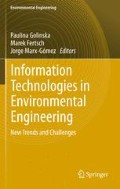Abstract
The chapter evolves Participatory Environmental Sensing (PES) as the new model of access, exchange and utilization of environmental information, resulting in the creation and adoption of sophisticated services that can lead to Quality of Life (QoL) support. The chapter addresses PES for QoL environmental information services, defines next steps for making PES for QoL part of the environmental monitoring and decision making process, and presents related developments in Thessaloniki, Greece. The environmental domain addressed is the quality of the atmospheric environment (air quality, pollen, and urban meteorology), as it affects the quality of life in various countries, especially in urban regions.
Access this chapter
Tax calculation will be finalised at checkout
Purchases are for personal use only
Preview
Unable to display preview. Download preview PDF.
References
Athanasiadis IN, Karatzas K and Mitkas P (2006). Classification techniques for air quality forecasting. Proceeding of the 5th ECAI Workshop on Binding Envi-ronmental Sciences and Artificial Intelligence, Riva del Garda, Italy
Burke J, Estrin D, Hansen M, Parker A, Ramanathan N, Reddy S and Srivastava B (2006). Participatory Sensing. WSW’06 at SenSys ’06, Boulder, Colorado, USA (http://www.sensorplanet.org/wsw2006/6_Burke_wsw06_ucla_final.pdf)
Cuff D, Hansen M and Kang J (2008). Urban Sensing: out of the woods. Communications of the ACM 51(3), pp 24-33
Fogg BJ and Ecklers D (2007). Mobile Persuasion: 20 Perspectives of the Future of Behavior Change, Stanford Captology Media; 1st edition.
Goldman J, Shilton K, Burke J, Estrin D, Hansen M, Ramanathan N, Reddy S, SamantaV, Srivastava M and West R (2009) Participatory Sensing: A Citizen-powered Approach to Illuminating the Patterns that shape our world. Wilson International Center for Scholars (http://wilsoncenter.org/topics/docs/participatory_sensing.pdf)
IEEE Spectrum (2009) Cell phones for Science. Issue Feb., p 12
Karatzas K and Moussiopoulos N (2000). Urban air quality management and information systems in Europe: legal framework and information access. Journal of Environmental Assessment Policy and Management 2, No. 2, pp 263-272
Karatzas K, Dioudi E and Moussiopoulos N (2003). Identification of major components for integrated urban air quality management and information systems via user requirements prioritization. Environmental Modelling and Software 18, pp 173-178
Karatzas K (2005). A quality-of-urban-life ontology for human centric, environmental information services. Presentation at the COST C21- Towntology meeting on WG1: Ontologies and Information Systems and Information Systems (available via http://www.towntology.net/Meetings/0512-BXL/presentations/C21_towntology_karatzas_brussels.pdf), Brussels, 12-13 Dec. 2005 (accessed 30.12.2010)
Karatzas K. (2006). Environmental Information Service Web. Meeting on Information and Communication Technologies for the Management of Natural Resources and Environmental Risks, 21.03.2006, available via ftp://ftp.cordis.europa.eu/pub/ist/docs/environment/karatzas_en.pdf (accessed 30.12.2010)
Karatzas Κ, Bassoukos Α., Voukantsis D., Tzima F., Nikolaou K. and Karathanasis S. (2008a) ICT technologies and computational intelligence methods for the creation of an early warning air pollution information system, Proceedings of the EnviroInfo 2008 (Environmental Informatics and Industrial Ecology) Int. Conference, A. Moehler, B. Page and M. Schreiber, eds. pp. 482-489. ISBN:978-3-8322-7313-2, Shaker Verlag, Aachen, 2008
Karatzas K, Papadourakis G and Kyriakidis I. (2008b) Understanding and forecasting atmospheric quality parameters with the aid of ANNs. IEEE World Congress on Computational Intelligence, vols. 1-8, pp 2580-2587, Hong Kong
Karatzas K (2009) Informing the public about atmospheric quality: air pollution and pollen. Allergo Journal 18, Issue 3/09, pp 212-217
Karatzas K and Kukkonen J (editors) (2009). COST Action ES0602: Quality of life information services towards a sustainable society for the atmospheric environment. Sofia Publishers, Thessaloniki, Greece, pp 118, ISBN: 978-960-6706-20-2 (available via http://www.chemicalweather.eu/material/COST.Action.ES0602.Quality.of.life.info.services.Karatzas.Kukkonen.eds.2009.pdf).
Kotovirta V. and Turtiainen H. (2010) From measurement to service: Environmental information into use. Presentation at SHOK Summit 20.4.2010, http://www.vtt.fi/ files/download/shok_summit_2010/shok_summit_2010_heikki_turtiainen.pdf
Lane N, Miluzzo E, Lu H, Peebles D, Choudhury T and Campbell AT (2010). A survey of mobile phone sensing, IEEE Communications Magazine 48(9), pp. 140-150
Paulos E, Foth M, Satchell Ch, Kim Y, Dourish P Hee-jeong Choi J (2008. Ubiquitous Sustainability: Citizen Science & Activism. Workshop at UbiComp, September 2008, paper available via http://www.paulos.net/papers/2008/Ubiquitous%20Sustainability%20%28Ubi Comp%202008%29.pdf (accessed 30.12.2010)
Miluzzo E, Lane ND, Eisenman SB and Campbell AT (2007). CenceMe - Injecting Sensing Presence into Social Networking Applications, In Proc. of Second European Conference on Smart Sensing and Context (EuroSSC 2007), Lake District, UK, October 23-25, 2007, LNCS 4793, pp 1-28. http://www.cs.dartmouth.edu/~miluzzo/papers/cenceme_EuroSSC07.pdf, (last accessed: 30.12.2010)
Pope CA 3rd, Ezzati M, Dockery DW. (2009). Fine-particulate air pollution and life expectancy in the United States. N Engl J Med. Jan 22; 360(4):413-5
Trausan-Matu S, Karatzas K. and Chiru C. (2007) Environmental information perception, analysis and communication with the aid of natural language processing. Proceedings of the 21st International Conference on Informatics for Environmental Protection - EnviroInfo2007, (Hryniewicz O., Studziński J. and Romaniuk M., eds.), vol. 1, pp 299-306, Shaker Verlag, Aachen, 2007, ISBN 978-3-8322-6397-3
Tzima FA, Karatzas KD, Mitkas PA and Karathanasis S (2007). Using data-mining techniques for PM10 forecasting in the metropolitan area of Thessaloniki, Greece. International Joint Conference on Neural Networks, pp. 2752-2757
Voukantsis D, Niska H, Karatzas K, Riga M, Damialis A and Vokou D (2010) Forecasting daily pollen concentrations using data-driven modeling methods in Thessaloniki, Greece. Atmospheric Environment, vol. 44, issue 39, pp. 5101-5111
Zhu L, Karatzas K and Lee J (2009). Urban environmental information perception and multimodal communication: the air quality example, Multimodal Signals: Cognitive and Algorithmic Issues (Anna Esposito, Amir Hussain, Maria Marinaro, Raffaele Martone, eds.), Lecture Notes in Artificial Intelligence 5398, Springer-Verlag Berlin Heidelberg, pp 288–299
Author information
Authors and Affiliations
Corresponding author
Editor information
Editors and Affiliations
Rights and permissions
Copyright information
© 2011 Springer-Verlag Berlin Heidelberg
About this chapter
Cite this chapter
Karatzas, K.D. (2011). Participatory Environmental Sensing for Quality of Life Information Services. In: Golinska, P., Fertsch, M., Marx-Gómez, J. (eds) Information Technologies in Environmental Engineering. Environmental Science and Engineering(), vol 3. Springer, Berlin, Heidelberg. https://doi.org/10.1007/978-3-642-19536-5_10
Download citation
DOI: https://doi.org/10.1007/978-3-642-19536-5_10
Published:
Publisher Name: Springer, Berlin, Heidelberg
Print ISBN: 978-3-642-19535-8
Online ISBN: 978-3-642-19536-5
eBook Packages: Earth and Environmental ScienceEarth and Environmental Science (R0)

